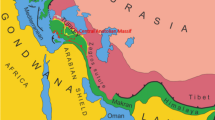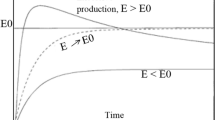Abstract
A comprehensive thermo-economic model combining a geothermal heat mining system and a direct supercritical CO2 turbine expansion electric power generation system was proposed in this paper. Assisted by this integrated model, thermo-economic and optimization analyses for the key design parameters of the whole system including the geothermal well pattern and operational conditions were performed to obtain a minimal levelized cost of electricity (LCOE). Specifically, in geothermal heat extraction simulation, an integrated well-bore-reservoir system model (T2Well/ECO2N) was used to generate a database for creating a fast, predictive, and compatible geothermal heat mining model by employing a response surface methodology. A parametric study was conducted to demonstrate the impact of turbine discharge pressure, injection and production well distance, CO2 injection flowrate, CO2 injection temperature, and monitored production well bottom pressure on LCOE, system thermal efficiency, and capital cost. It was found that for a 100 MWe power plant, a minimal LCOE of $0.177/kWh was achieved for a 20-year steady operation without considering CO2 sequestration credit. In addition, when CO2 sequestration credit is $1.00/t, an LCOE breakeven point compared to a conventional geothermal power plant is achieved and a breakpoint for generating electric power generation at no cost was achieved for a sequestration credit of $2.05/t.
Similar content being viewed by others
Abbreviations
- R :
-
The radial distance from the injection well to production well/m
- D :
-
Diameter of well/m
- ṁ :
-
Mass flowrate/(kg·s−1)
- T :
-
Temperature/°C
- P :
-
Pressure/MPa
- h :
-
Specific enthalpy/(kJ·kg−1)
- s :
-
Isentropic process
- Q :
-
Thermal energy/kWth
- v :
-
Velocity/(m·s−1)
- z :
-
Well depth/m
- S :
-
Well drilling successful rate/%
- C :
-
Cost/M$
- F capacity :
-
Capacity factor
- F insurance&taxes :
-
Taxes and insurance factor
- i :
-
Annual interest rate/%
- n :
-
Loan period/a
- \({b_{{\rm{C}}{{\rm{O}}_2}}}\) :
-
CO2 sequestration credit/($·t−1)
- V :
-
Volume flowrate//(L·min−1)
- N wellset :
-
Number of well-set required
- W :
-
Power plant capacity/MWe
- e :
-
Error in RSM design
- r 2 :
-
Coefficient of determination
- t :
-
Turbine
- comp:
-
Compressor
- inj:
-
Injection well
- prod:
-
Production well
- reinj:
-
Re-injection well
- dis:
-
Discharge
- opt:
-
Optimal value
- th:
-
Thermal
- α :
-
RSM regression coefficient
- ε :
-
Heat exchanger effectiveness
- ρ :
-
Density//(kg·m−3)
- η :
-
Efficiency
- sCO2 :
-
Supercritical carbon dioxide
- RSM:
-
Response surface methodology
- LCOE:
-
Levelized cost of electricity
- O&M:
-
Operation and maintenance
- HX:
-
Heat exchanger
- APF:
-
Annual payment factor
- M$:
-
Million US Dollars
References
Romero C E, Wang X. Key technologies for ultra-low emissions from coal-fired power plants. In: Zhang Y S, Wang T, Pan W P, Romero C E, eds. Advances in Ultra-low Emission Control Technologies for Coal-fired Power Plants. Amsterdam: Elsevier, 2019: 39–79
OSTI. GOV. Electric power monthly. Technical Report, Office of Scientific and Technical Information (OSTI), 1995
Figueroa J D, Fout T, Plasynski S, et al. Advances in CO2 capture technology—the US Department of Energy’s carbon sequestration program. International Journal of Greenhouse Gas Control, 2008, 2(1): 9–20
Randolph J B, Saar M O. Coupling carbon dioxide sequestration with geothermal energy capture in naturally permeable, porous geologic formations: implications for CO2 sequestration. Energy Procedia, 2011, 4: 2206–2213
Pan C, Chávez O, Romero C E, et al. Heat mining assessment for geothermal reservoirs in Mexico using supercritical CO2 injection. Energy, 2016, 102: 148–160
Garapati N, Randolph J B, Saar M O. Brine displacement by CO2, energy extraction rates, and lifespan of a CO2-limited CO2-Plume Geothermal (CPG) system with a horizontal production well. Geothermics, 2015, 55: 182–194
Adams B M, Kuehn T H, Bielicki J M, et al. A comparison of electric power output of CO2 Plume Geothermal (CPG) and brine geothermal systems for varying reservoir conditions. Applied Energy, 2015, 140: 365–377
Adams B M, Kuehn T H, Bielicki J M, et al. On the importance of the thermosiphon effect in CPG (CO2 plume geothermal) power systems. Energy, 2014, 69: 409–418
Zhang L, Cui G, Zhang Y, et al. Influence of pore water on the heat mining performance of supercritical CO2 injected for geothermal development. Journal of CO2 Utilization, 2016, 16: 287–300
Ahn Y, Bae S J, Kim M, et al. Review of supercritical CO2 power cycle technology and current status of research and development. Nuclear Engineering and Technology, 2015, 47(6): 647–661
Turchi C S, Ma Z W, Dyreby J. Supercritical carbon dioxide power cycle configurations for use in concentrating solar power systems. In: Proceedings of ASME Turbo Expo 2012: Turbine Technical Conference and Exposition, Copenhagen, Denmark, 2013
Persichilli M, Kacludis A, Zdankiewicz E, et al. Supercritical CO2 power cycle developments and commercialization: why sCO2 can displace steam. In: Power-Gen India & Central Asia, New Delhi, India, 2012
Wright S A, Conboy T M, Rochau G E, et al. Supercritical CO2 power cycle development summary at Sandia National Laboratories. In: 1st International Seminar on Organic Rankine Cycle Power Systems, Delft, Netherlands, 2011
Mecheri M, Le Moullec Y. Supercritical CO2 Brayton cycles for coal-fired power plants. Energy, 2016, 103: 758–771
Noaman M, Saade G, Morosuk T, et al. Exergoeconomic analysis applied to supercritical CO2 power systems. Energy, 2019, 183: 756–765
Park S, Kim J, Yoon M, et al. Thermodynamic and economic investigation of coal-fired power plant combined with various supercritical CO2 Brayton power cycle. Applied Thermal Engineering, 2018, 130: 611–623
Sharan P, Neises T, Turchi C. Thermal desalination via supercritical CO2 Brayton cycle: optimal system design and techno-economic analysis without reduction in cycle efficiency. Applied Thermal Engineering, 2019, 152: 499–514
Li M, Xu J, Cao F, et al. The investigation of thermo-economic performance and conceptual design for the miniaturized lead-cooled fast reactor composing supercritical CO2 power cycle. Energy, 2019, 173:174–195
Atrens A D, Gurgenci H, Rudolph V. Economic optimization of a CO2-based EGS power plant. Energy & Fuels, 2011, 25(8): 3765–3775
Levy E K, Wang X, Pan C, et al. Use of hot supercritical CO2 produced from a geothermal reservoir to generate electric power in a gas turbine power generation system. Journal of CO2 Utilization, 2018, 23: 20–28
Wang X C. Investigation of geothermal heat extraction using supercritical carbon dioxide (sCO2) and its utilization in sCO2-based power cycles and organic Rankine cycles-a thermodynamic & economic perspective. Dissertation for the Doctoral Degree. Bethlehem: Lehigh University, 2018
Wang X, Levy E K, Pan C, et al. Working fluid selection for organic Rankine cycle power generation using hot produced supercritical CO2 from a geothermal reservoir. Applied Thermal Engineering, 2019, 149: 1287–1304
Pruess K, Oldenburg C M, Moridis G J. TOUGH2 User’s Guide Version 2[R]. Office of Scientific and Technical Information (OSTI), 1999, available at the website of digital.library.unt.edu
Pruess K. ECO2N: A TOUGH2 Fluid Property Module for Mixtures of Water, NaCl, and CO2[R]. Office of Scientific and Technical Information (OSTI), 2005, available at the website of tough.lbl.gov
Pan C, Romero C E, Levy E K, et al. Fully coupled wellborereservoir simulation of supercritical CO2 injection from fossil fuel power plant for heat mining from geothermal reservoirs. Journal of CO2 Utilization, 2018, 27: 480–492
Pan L, Freifeld B, Doughty C, et al. Fully coupled wellborereservoir modeling of geothermal heat extraction using CO2 as the working fluid. Geothermics, 2015, 53: 100–113
Pan L, Oldenburg C M. T2Well—an integrated wellbore-reservoir simulator. Computers & Geosciences, 2014, 65: 46–55
Pan L, Webb S W, Oldenburg C M. Analytical solution for two-phase flow in a wellbore using the drift-flux model. Advances in Water Resources, 2011, 34(12): 1656–1665
Bezerra M A, Santelli R E, Oliveira E P, et al. Response surface methodology (RSM) as a tool for optimization in analytical chemistry. Talanta, 2008, 76(5): 965–977
Montgomery D C. Design and Analysis of Experiments. Hoboken, USA: John Wiley & Sons, 2017
Gunst R F, Myers R H, Montgomery D C. Response surface methodology: process and product optimization using designed experiments. Technometrics, 1996, 38(3): 285
Plus ASPEN. Aspen technology. Inc., version. 2009, available at the website of aspentech.com
Peletiri S, Rahmanian N, Mujtaba I. CO2 pipeline design: a review. Energies, 2018, 11(9): 2184
Vandeginste V, Piessens K. Pipeline design for a least-cost router application for CO2 transport in the CO2 sequestration cycle. International Journal of Greenhouse Gas Control, 2008, 2(4): 571–581
Sanyal S K. Cost of geothermal power and factors that affect it. In: Proceedings of 29th Workshop on Geothermal Reservoir Engineering, Stanford, California, USA, 2004
Gross R, Heptonstall P, Blyth W. Investment in electricity generation: the role of costs, incentives and risks. Imperial College Centre for Energy Policy and Technology (ICEPT) for the Technology and Policy Assessment Function of the UK Energy Research Centre, 2007
Boggs P T, Tolle J W. Sequential quadratic programming. Acta Numerica, 1995, 4: 1–51
Rubin E S, Chen C, Rao A B. Cost and performance of fossil fuel power plants with CO2 capture and storage. Energy Policy, 2007, 35(9): 4444–4454
USCODE. 26 USC 45Q: credit for carbon oxide sequestration. 2018, available at the website of uscode.house.gov
Turton R, Bailie R C, Whiting W B, et al. Analysis, Synthesis, and Design of Chemical Processes (Prentice-Hall International Series in the Physical and Chemical Engineering Sciences). 2nd ed. Upper Saddle River, N.J.: Prentice Hall/PTR, 2003
Silla H. Chemical Process Engineering: Design and Economics. Boca Raton: CRC Press, 2003
McCollum D L, Ogden J M. Techno-economic models for carbon dioxide compression, transport, and storage & correlations for estimating carbon dioxide density and viscosity. 2006, available at the website of ideas.repec.org
Lemmon E W, Huber M L, McLinden M O. NIST reference fluid thermodynamic and transport properties-REFPROP. 2019–4, available at the website of nist.gov
Morris D. RSMeans Mechanical Cost Data. 40th annual edition, Cordian RSMeans Data, Rockland, MA, USA, 2017
Charles J. Communications with sales rep from Mueller Environmental Designs, Inc. 2017, available at the website of muellerenvironmental.com
Qiao Z, Tang Y, Zhang L, et al. Design and performance analysis of a supercritical CO2 (sCO2)-water separator for power generation systems using hot sCO2 from geothermal reservoirs. Geothermics, 2019, 81: 123–132
Acknowledgements
This work was funded by the Mexican National Council of Science and Technology (CONACYT in Spanish), under the Sectorial Fund for Energy Sustainability, CONACYT-Secretary of Energy (No. S0019-2012-04).
Author information
Authors and Affiliations
Corresponding author
Electronic Supplementary Material
Rights and permissions
About this article
Cite this article
Wang, X., Pan, C., Romero, C.E. et al. Thermo-economic analysis of a direct supercritical CO2 electric power generation system using geothermal heat. Front. Energy 16, 246–262 (2022). https://doi.org/10.1007/s11708-021-0749-9
Received:
Accepted:
Published:
Issue Date:
DOI: https://doi.org/10.1007/s11708-021-0749-9




